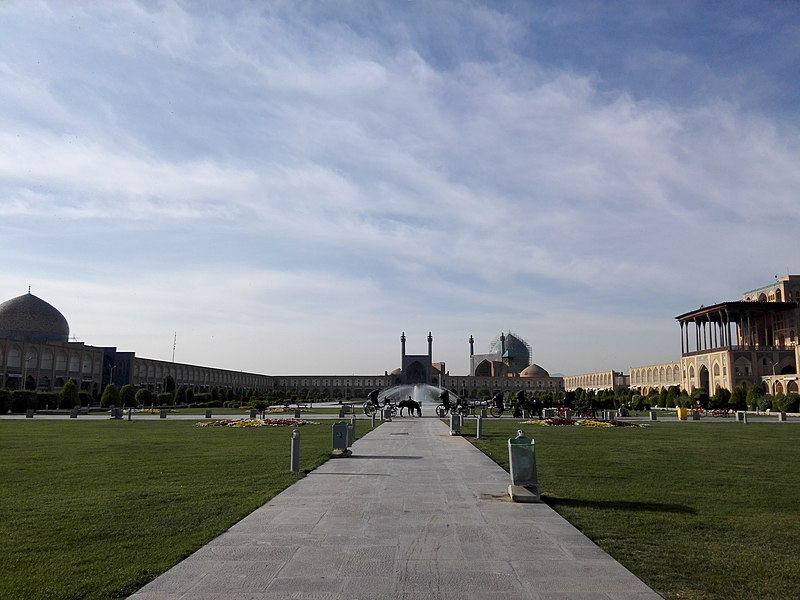Islamic architecture
Islamic architecture encompasses a wide range of both secular and religious styles from the foundation of Islam to the present day, influencing the design and construction of buildings and structures in Islamic culture. The principal Islamic architectural types are: the Mosque, the Tomb, the Palace and the Fort. From these four types, the vocabulary of Islamic architecture is derived and used for buildings of lesser importance such as public baths, fountains and domestic architecture.
The Shah Mosque, constructed in 1629, in Isfahan, Iran.
Si-yo-se-pol, Isfahan, Iran
The interior side view of the main dome of Selimiye Mosque in Edirne, Turkey.
Dome of Al Othman Mosque in Hawalli, Kuwait
Influences
Arabic Calligraphy on large pishtaq of the Taj Mahal. A specifically recognisable Islamic architectural style emerged soon after Muhammad's time, inspired by Islam with addition of localized adaptations of the former Sassanid and Byzantine models, the Germanic Visigoths in Spain also made a big contribution to Islamic architecture They invented the Horseshoe arch in Spain and used them as one of their main architectural features, After the moorish invasion of Spain in 711 AD the form was taken by the Ummayyads who accentuated the curvature ofthe horseshoe.The Dome of the Rock (Qubbat al-Sakhrah) in Jerusalem (691) is one of the most important buildings in all of Islamic architecture, marked by a strong Byzantine influence (mosaic against a gold background, and a central plan that resembles that of the Church of the Holy Sepulchre, although the church itself was renovated several times in the Islamic period), but already bearing purely Islamic elements, such as the great epigraphic frieze. It featured interior vaulted spaces, a circular dome, and the use of stylized repeating decorative arabesque patterns. The desert palaces in Jordan and Syria (for example, Mshatta, Qasr Amra, and Khirbat al-Mafjar) served the caliphs as living quarters, reception halls, and baths, and were decorated to promote an image of royal luxury.
Arabic Calligraphy on large pishtaq of the Taj Mahal
Dome of the mihrab in the Great Mosque of Kairouan
also known as the Mosque of Uqba, in Kairouan,
Tunisia
Religious and civic architecture were developed under the Umayyads, when new concepts and new plans were put into practice. Thus, the “Arab plan,” with court and hypostyle prayer
hall, truly became a functional type with the construction of the Umayyad Mosque, or the Great Mosque of Damascus (completed in 715 by caliph Al-Walid ) on top of the ancient temple of Jupiter and in place of the basilica of St. John the Baptist, the most sacred site in the city. This building served as a point of reference for builders (and for art historians) for the birth of the Arab plan, as Byzantine Christian. The Abbasid dynasty (750 A.D.- 1258[6] ) witnessed the movement of the capital from Damascus to Baghdad, and then
from Baghdad to Samarra. The shift to Baghdad influenced politics, culture, and art. The Great Mosque of Samarra, once the largest in the world, was built for the new capital. Other major mosques built in the Abbasid Dynasty include the Mosque of Ibn Tulun in Cairo, Abu Dalaf in Iraq, the great mosque in Tunis.
Abbasid architecture in Iraq as exemplified in the Fortress of Al-Ukhaidir (c.775-6) demonstrated the "despotic and the pleasure-loving character of the dynasty" in its grand size but cramped living quarters. The Great Mosque of Kairouan (in Tunisia), considered as the ancestor of all the mosques in the western Islamic world, is one of the best preserved and most significant examples of early great mosques. Founded in 670 AD, it dates in its present form largely from the Aghlabid period (9th century).[9] The Great Mosque of Kairouan is constituted of a massive square minaret, a large courtyard surrounded by porticos and a huge hypostyle prayer hall covered on its axis by two cupolas. The Great Mosque of Samarra in Iraq, completed in 847 AD, combined the hypostyle architecture of rows of columns supporting a flat base above which a huge spiraling minaret was constructed.
The Hagia Sophia in Istanbul also influenced Islamic architecture. When the Ottomans captured the city from the Byzantines, they converted the basilica to a mosque (now a museum) and incorporated Byzantine architectural elements into their own work (e.g. domes). The Hagia Sophia also served as a model for many Ottoman mosques such as the Shehzade Mosque, the Suleiman Mosque, and the Rüstem Pasha Mosque. Distinguishing motifs of Islamic architecture have always been ordered repetition, radiating structures, and rhythmic, metric patterns. In this respect, fractal geometry has been a key utility, especially for mosques and palaces. Other significant features employed as motifs include columns, piers and arches, organized and interwoven with alternating sequences of niches and colonnettes.The role of domes in Islamic architecture has been considerable. Its usage spans centuries, first appearing in 691 with the construction of the Dome of the Rock, and recurring even up until the 17th century with the Taj Mahal. As late as the 19th century, Islamic domes had been incorporated into Western architecture.







No comments:
Post a Comment